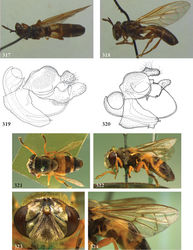Pseudomicrodon smiti
| Notice: | This page is derived from the original publication listed below, whose author(s) should always be credited. Further contributors may edit and improve the content of this page and, consequently, need to be credited as well (see page history). Any assessment of factual correctness requires a careful review of the original article as well as of subsequent contributions.
If you are uncertain whether your planned contribution is correct or not, we suggest that you use the associated discussion page instead of editing the page directly. This page should be cited as follows (rationale):
Citation formats to copy and paste
BibTeX: @article{Reemer2013ZooKeys288, RIS/ Endnote: TY - JOUR Wikipedia/ Citizendium: <ref name="Reemer2013ZooKeys288">{{Citation See also the citation download page at the journal. |
Ordo: Diptera
Familia: Syrphidae
Genus: Pseudomicrodon
Name
Pseudomicrodon smiti Reemer sp. n. – Wikispecies link – ZooBank link – Pensoft Profile
Type specimens
HOLOTYPE. Adult male. PERU. Label 1: “PERU. Madre de Dios, Tambopata / Sachavacayoc Centre, Bridge / Condonado trail, S 12°51'25.7” - / W 69°22'23.1”. Alt. 184 m. / 5.VI.2010. Leg. J.T. Smit”. Label 2: “Voucher code M. Reemer / 345 / DNA voucher labcode MZH:Y1318”. Coll. RMNH (preliminary deposition, to be transferred to relevant Peruvian collection later).
PARATYPES. A male and a female from same locality as holotype, collected on 10.VI and 8.VI.2010, respectively. Male in coll. J.T. Smit, female in coll. RMNH.
Diagnosis
In three other described Pseudomicrodon speciesthe alula is completely microtrichose: Pseudomicrodon chrysostypus (Thompson, 2004), Pseudomicrodon pilosops (Marinoni, 2004) and Pseudomicrodon polistoides sp. n. From these species, Pseudomicrodon smiti sp. n. differs by the combination of the black postpronutum and the partly black hind tibia.
Description (based on holotype)
Adult male. Body size: 9.5 mm.
Head. Face occupying a little more than 1/4 of head width in frontal view; black, except yellow on lateral 1/5 in dorsal 2/3; entirely yellow pilose; medially with vitta of transversely wrinkled texture. Gena black; yellow pilose. Lateral oral margins weakly produced. Frons black; white pilose. Vertex black; bare on anterior half, black pilose on posterior half. Occiput black; golden pilose on dorsal half, silvery white pilose on ventral half. Eye almost bare, with very sparse and short white pile. Antennal fossa about 1.5 times as wide as high. Antenna black; antennal ratio approximately as 2.5:1:3.5; longer than distance between antennal fossa and anterior oral margin.
Thorax. Blackish brown with bronze and green metallic hues. Mesoscutum appressed black pilose, except for medially interrupted fasciae of appressed golden pile along anterior margin and transverse suture. Postpronotum and postalar callus black pilose. Scutellum semicircular; black pilose, except golden pilose posterolaterally; with calcars about as long as 1/3 of length of scutellum, with mutual distance approximately 1/4 of scutellar width. Anepisternum sulcate; black pilose anterodorsally, white pilose posteriorly, widely bare in between. Anepimeron entirely silvery white pilose. Katepisternum silvery white pilose dorsally, bare ventrally. Katatergum long microtrichose, anatergum short microtrichose. Calypter and halter yellowish white.
Wing: Hyaline, brownish in cells bc, c and sc, and cell r1. Microtrichose, except bare cell bc, posterobasal 3/4 of cell br, basal 2/3 of cell bm and basal 1/6 of cell cup.
Legs: Blackish brown, except whitish on basal 1/3 of mid tibia and basal 2/5 of hind tibia, paler brown on apical half of femora. Femora black pilose, except hind femur white pilose posteriorly and anterobasally. Tibiae white pilose, except black pilose ventrally, and mid tibia black pilose on apical 2/5. Tarsi dorsally black pilose. Coxae brown; front and mid coxae black pilose, hind coxa white pilose. Trochanters brown; black pilose.
Abdomen. Constricted, narrower than thorax, with narrowest point halfway of tergite 2. Tergites black, except tergite 2 largely occupied by pair of rectangular yellow maculae on basal 3/4. Tergite 1 long yellowish white pilose laterally, black pilose dorsally. Tergite 2 black pilose, except narrowly golden pilose along posterior margin. Tergite 3 black pilose, except white pilose along lateral margin and with medially interrupted fascia of golden pile along posterior margin. Tergite 4 black pilose, except white pilose anterolaterally and along lateral margin, and with pair of submedian vittae of golden pile on posterior 3/4, widening towards apex. Sternite 1 black; bare. Sternite 2 whitish yellow; bare. Sternites 3 and 4 black; black pilose. Male genitalia as in Fig. 320.
Female. Body size: 11 mm. As male, except for usual sexual differences. Tergite 5 golden pilose medially, white pilose laterally.
Etymology
This species is named after John T. Smit, who collected this species in Peru, along with several other interesting Microdontinae. The epithet is a noun in the genitive case.
Original Description
- Reemer, M; Ståhls, G; 2013: Generic revision and species classification of the Microdontinae (Diptera, Syrphidae) ZooKeys, 288: 1-213. doi
Images
|

